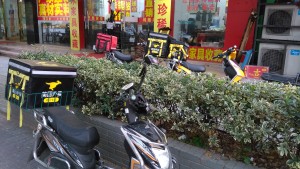Shanghai Street View: Delivered Out

More than a month after Shanghai launched its campaign to tame our unruly traffic, I want to use this space to call for a similar campaign that is badly needed to clean up our city’s increasingly chaotic sidewalks. Anyone who lives here will know I’m talking about the legions of delivery bikes and scooters that have exploded onto Shanghai’s sidewalks over the last few years, creating a nightmare for those of us who actually use sidewalks for walking.
This particular tale began 5 or 6 years ago with the rapid rise of e-commerce, which spawned a flood of courier services delivering everything from major items like computers and furniture to tiny parcels like USB thumb drives. But the problem has become much worse over the last year with a newer explosion of take-out dining services, which have unleashed thousands more bikes and scooters onto our sidewalks.
This relatively sudden and massive introduction of delivery scooters has made our sidewalks look similar to the bicycle lanes that used to be quite common in China just 20 years ago but have largely disappeared in today’s Shanghai. Perhaps the city should consider bringing back these lanes to accommodate all the new delivery vehicles, though at this point such a move would probably just worsen traffic congestion that is already quite severe.
I first chronicled the sudden boom in take-out dining services nearly a year ago, noting the trend with some amusement and predicting it would be short-lived. Perhaps that’s still true, but in the meantime the phenomenon has exploded over the last half year.
On any given day, I can spot dozens of take-out dining scooters zipping up and down the streets and sidewalks near my home in Hongkou District. And rather than consolidating due to the sudden stiff competition, the field of names seems to keep getting bigger. Just this week I discovered yet another new entrant to the field, a company called Feng Niao, which I learned from one of its deliverymen has a relationship with Ele.me, the earliest major player.
That pair, with their trademark blue-and-white food pouches, are just two of the many names whose bikes are taking over our sidewalks. Others include Baidu (Nasdaq: BIDU), with its red-and-white pouches and their fork logos; Meituan, with its black-and-yellow pouches and kangaroo logos; and smaller names like Dada and Dianwoba. One restaurant near my home has become a watering hole for Meituan and Ele.me couriers, with up to 20 of their bikes parked randomly outside on the sidewalk at any given time.
The situation is equally bad around the university where I teach in suburban Yangpu District. One recent day I noticed two delivery bikes drop off food in just a couple of minutes through a locked gate at one of the main dormitory areas. So I stayed and watched for the next 10 or 15 minutes, and saw a steady stream of deliverymen dropping off food at around the rate of every 2 or 3 minutes.
Feeding Rising Obesity
The phenomenon should be alarming not only for what it’s doing to our sidewalks, but also for the bigger implications for our city’s youth who are some of these services’ biggest fans. I don’t mean to sound like a grumpy old man, but this younger generation doesn’t seem to want to leave their homes or dormitories for anything, preferring to do all their shopping and dining using their computers.
That tendency is certainly not helping China’s growing battle with youth obesity. A recent poll conducted in Shandong is typical of the broader national situation, showing 17 percent of boys and 9 percent of girls between 7 and 18 were obese. That marked a huge rise from 30 years earlier, when less than 1 percent of children from that age group fit that description.
All of that brings us back to the delivery bike phenomenon and what, if anything, the city should do to make our sidewalks friendlier for pedestrians. I remember a time just a few years ago when our sidewalks were equally cluttered, though in that case the culprits were illegal hawkers selling everything from greasy street food to cheap clothing and accessories.
The city embarked on a campaign to clean up that clutter a few years ago with surprisingly good results, and should consider a similar campaign now. In this case it’s probably unrealistic to outlaw these scooters and bikes completely, since most are probably operating legally and provide a real service that people want and need.
But perhaps the city could consider rules that would force deliverymen to walk their scooters on sidewalks rather than ride, and also to park in designated areas rather than in any random spot. Local officials are showing they are capable of such efforts through their ongoing traffic clean-up campaign, and should seriously consider launching a similar new effort for these delivery bikes.
